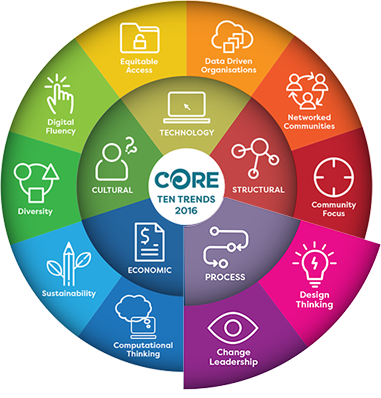Design Thinking

In a world full of complexity, we are required more than ever to work together to create new solutions, to innovate and to accelerate change to solve problems together. Design Thinking has become a popular methodology for enabling and fostering innovation and creativity and is now permeating the world of education.
Design Thinking moves through a disciplined process of: Immersion; Synthesis; Ideation, Prototyping & Feedback; and Implementation in order to avoid assumptions and surface level understanding of people’s needs and organisational problems.
Implications and impact
To engage in Design Thinking means learning more about collaboration and “slowing down to speed up”. Bringing multiple perspectives toward a co-developed vision is now necessary, not optional, in solving complex problems. This involves:
- encouraging the consideration of existing practices and related issues from multiple perspectives
- taking a problem-based approach and encouraging a strong problem-solving approach
- using a ground-up approach to reaching a people-focused goal ensuring that all staff have a say in their development needs
- encouraging the creation and testing of many potential ideas for solving problems rather than settling too early on “the right answer”
- ensuring the deep involvement and input of others including learners and their whānau.
Design Thinking is a process that can support us to shift from improvement and reform approaches towards ways that encourage transformation and a “learning revolution” (Robinson, K, 2010). It can help us to respond to and prepare our learners for the demands of business sector and the rapidly shifting job market as technology replaces many process-driven tasks. It can also help us to empower our learners to be proactive when working with real-world complex problems. This is because Design Thinking processes help to build the skills and capabilities needed for learners to navigate multiple perspectives, to find common ground and to create “messy” solutions that haven’t been thought of before.
Navigating multiple perspectives is particularly relevant in a multicultural society. Charles Royal illustrated a potential way forward in his “Creative Potential Paradigm” (2007). In this paradigm, he promotes a shift away from Māori being dominated by the quest for social justice and the desire for cultural restoration towards a creative potential paradigm where Māori consciously articulate a way by which matters of social justice and cultural restoration might be addressed. He says that this is a positioning of social justice and cultural restoration within a larger paradigm of creativity and innovation - things that are not new to Māori and that challenge Māori to undertake activities that are inspired by something deep within their own iwi backgrounds, culture and experience, but are also activities to which many people may connect with, be inspired by and be proud of. This involves taking away any boundaries between Māori people and all other people and shifting to boundaries and lines between philosophies and world-views. In the transformation era, with processes like Design Thinking to support us, this type of thinking fits. It is a way to take what we know works from the past to bring it into today.
Challenges
As we are continuously exposed to new ways of thinking and doing in education, we must learn to work fluidly with a wide range of processes that support the learner. Knowing why we are selecting Design Thinking as a process, and then doing it well, are both important. A challenge that we often face in the education sector is that we don’t seem to like talking about problems and we see this as deficit thinking. However, Design Thinking encourages positive, strengths-based thinking in the problem-based context.
As Grant Lichtman found on his recent #edjourney, innovation and transformation is enabled when senior management sits back and let innovation teams work with real autonomy. “Sometimes the teams fail; they miss deadlines; their ideas are unrealistic; their proposed innovations are flashes-in-the-pan...Management does not step in and direct the team to reach a different solution” (Lichtman, p. 79)
Teaching as Inquiry processes such as the Spirals of Inquiry support and encourage the involvement of learners and their whānau in the transformation of learning and innovation in schools. The importance of collective professional agency is emphasised, as is the use of current learning science knowledge (Timperley, Kaser & Halbert). While the Spirals of Inquiry focus strongly on disciplined collaborative inquiry to create new solutions, Design Thinking processes can complement Spirals of Inquiry by creating an additional lens to support innovation. Timperley, Kaser and Halbert (2014) highlight that “innovation floats on a sea of inquiry and curiosity is a driver for change”. Together, Design Thinking and Spirals of Inquiry can be a powerful vehicle for collaborative innovation, creativity and change in schools, kura and services.
Questions to consider
- How might a disciplined Design Thinking process float on strong Teaching as Inquiry processes in your school, kura or service?
- How can we learn from the ways that businesses, not-for-profits and other organisations are currently innovating to solve complex problems?
Videos
-
Links
Design Thinking for Educators – What kind of challenges can be addressed using Design Thinking
Grant Lichtman, 2014. #edjourney: a roadmap to the future of education
Ewan McIntosh, 2014. How to come up with great ideas and actually make them happen
The B Team – For a better way of doing business for the wellbeing of people and planet
-
Articles
-
Research